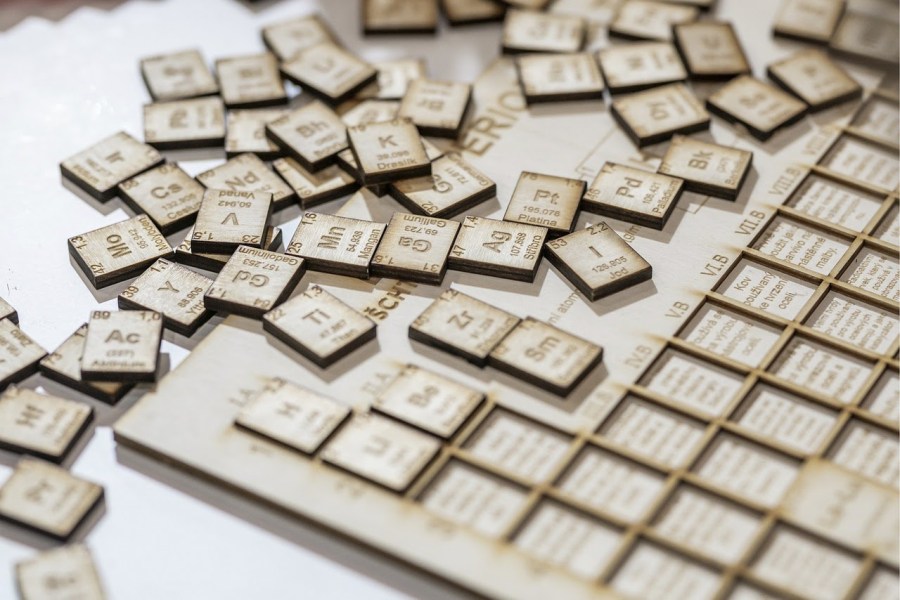Funny Quotes That Words Can Be Substituted With Elements Names

The elements in the periodic table are substances that are made of only one atom. Scientists have given the elements in the table names for different reasons. Some names come from Latin or Greek, while others are named after places and people. Four of the elements got their names from planets: uranium, plutonium, neptunium and tellurium.
Uranium
Uranium is a radioactive element, which means that it's unstable and always in a state of decay. Uranium is always in search of stability. It's radioactive quality is what led American scientists to use it in the first atomic bomb that was dropped on Hiroshima, Japan, on August 6, 1945. It's number 92 on the periodic table, which means that it has 92 protons and 92 electrons.
German chemist Martin Heinrich Klaproth discovered the element in 1789 and named it after Uranus. In 1897, French physicist Henri Becquerel did an experiment where he left uranium salts on a photographic plate overnight to see how light would affect them. When he looked at the plate the next morning, Becquerel noticed the plate had fogged up. This led him to conclude that the element exposed the plate to radiation. He won the Nobel Prize in 1903, along with Marie and Pierre Curie, for this discovery.
N eptunium
Neptunium is another unstable radioactive element. It occupies 93 on the periodic table, which means that it has 93 protons and 93 electrons. It was the first man-made element with more protons and electrons than uranium.
Professor Edwin McMillan and graduate student Philip Abelson at the University of California at Berkeley used a special machine to slow neurons down and bombard a uranium element with them. The result was a new element. They named it after Neptune because it was the first planet beyond Uranus. McMillan received the Nobel Prize in 1951 for creating neptunium.
P lutonium
In 1941, a group of scientists at the University of California at Berkeley performed experiments with uranium and neptunium. They created another radioactive element, this time with 94 protons and 94 electrons. The scientists, Glenn T. Seaborg, Edwin McMillan, Joseph W. Kennedy, and Arthur Wahl, named the new element plutonium. It's named after the planet Pluto, which lies beyond Uranus and Neptune.
Nuclear scientists used plutonium in the second atomic bomb used in warfare, which the United States dropped on Nagasaki, Japan, on August 9, 1945. After World War II, nuclear physicists discovered they could use plutonium and uranium to create energy. Today, those two elements are used in nuclear power plants to provide clean electricity.
T ellurium
It's easy to tell that uranium, neptunium and plutonium get their names from planets, but one other element is named for a planet: tellurium. Franz Joseph Müller von Reichenstein, a mining official in Transylvania, or present day Romania, discovered the element in 1782. Seventeen years later, Martin Heinrich Klaproth began to research this material. He named it after the Latin word for the planet Earth: Tellus.
Today, manufacturers use tellurium for several different purposes. Ceramics and glass artisans can use it to color their items. It's also used for making blasting caps. Metalworkers add tellurium to lead to make it stronger. They add it to stainless steel and copper to make them easier to craft with.
O ther Elements Named for Celestial Bodies
Several other elements have names that come from the names of bodies in the solar system. Cerium and palladium get their names from Ceres and Pallas, the first two asteroids to be discovered. Helium derives its name from Helios, the Greek name for the sun. Selenium is named for Selene, the Greek name for the moon. Although the element mercury shares its name with the planet Mercury, it's not named after the planet. They both get their name from the Roman god of the same name.
Source: https://www.reference.com/science/elements-named-after-planets-99efe16e78c884de?utm_content=params%3Ao%3D740005%26ad%3DdirN%26qo%3DserpIndex